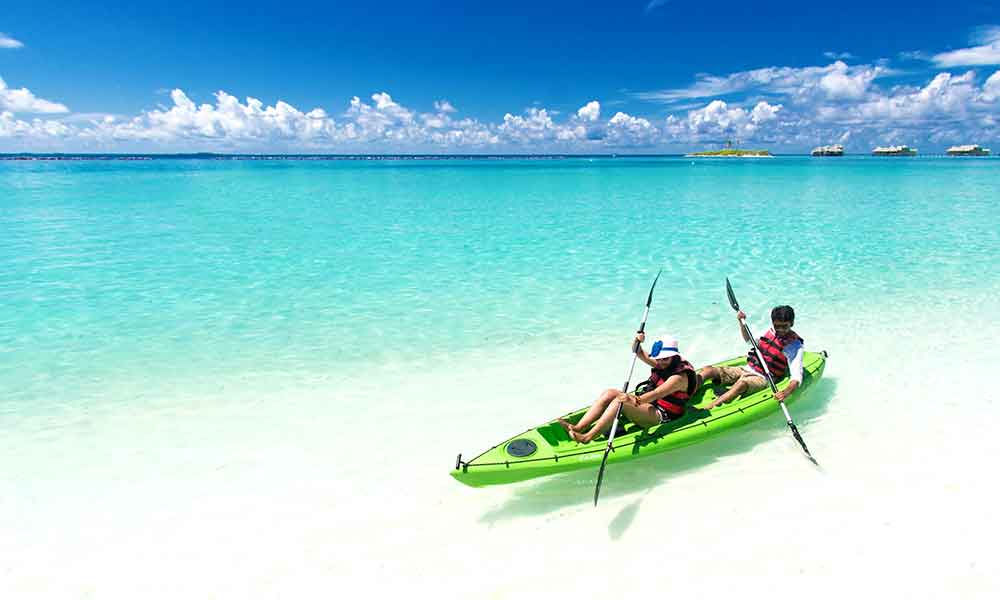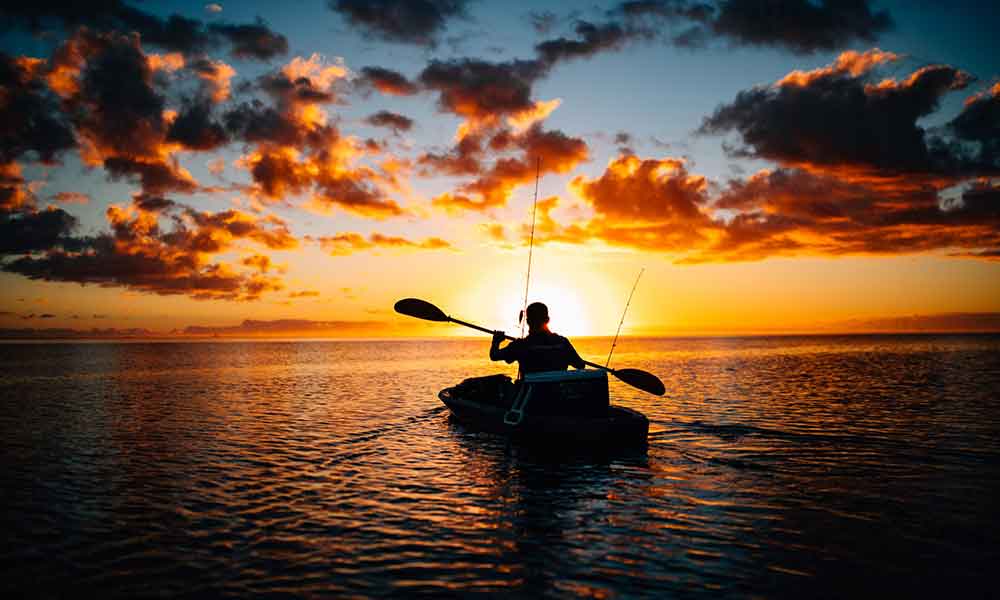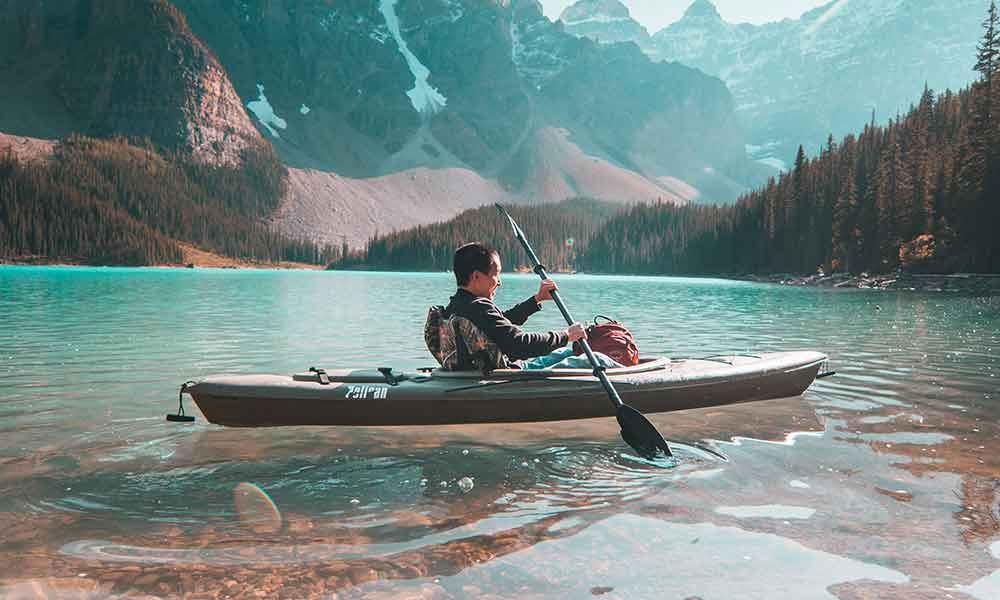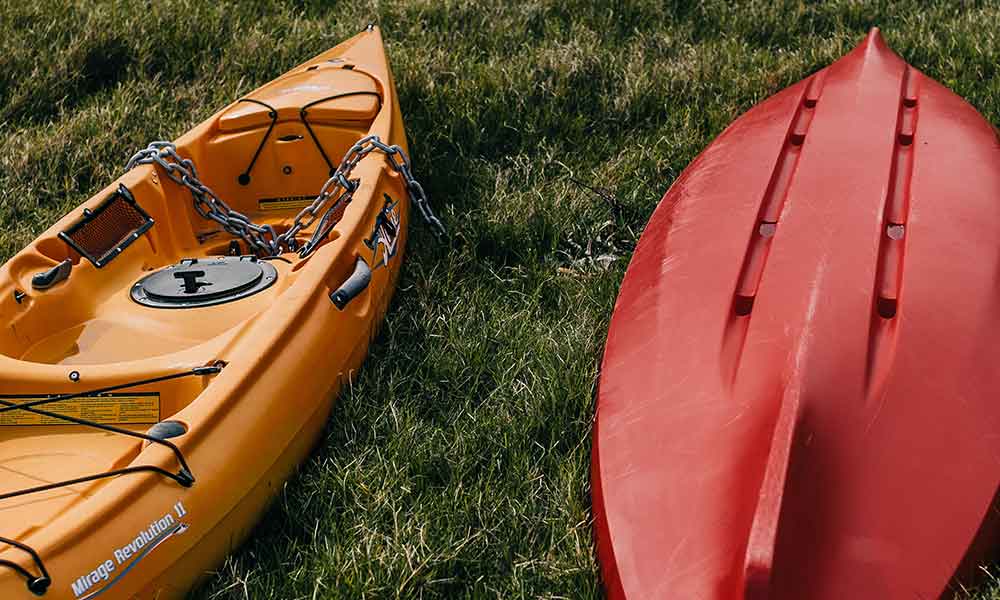Kayaking is a low-in-the-water open boat that resembles a canoe. It is different from a canoe in the water that the passenger is seated, the positioning of the paddles, and how the paddles are used. Kayaks are very versatile and are used in many sport or tourism applications. To gain the most enjoyment from the sport, you must know how to kayak.
The most efficient way to kayak is by learning the correct grip and use of the paddle and mastering the basic four strokes – the forward, reverse, sweep and draw strokes. The most fundamental stroke for paddling is the forward stroke which will be the most used to propel the kayak forward.
Kayaking, like any watersport, has a set of fundamental principles, rules, and best practices. Since you are on the water for long periods, it is best to avoid shortcuts and take your time learning the basics, and practice as much as possible. Let’s look at how to kayak more in-depth.
How To Paddle A Kayak
The ability to efficiently control your kayak on the water is the key to having a great time without struggling to get in, going in circles, or worse, capsizing. A kayak is rather difficult to maneuver if you are a beginner and depending on the size or type, it can be quite heavy. Here are some things you need to learn;
- How the paddle works and how to grip it for efficiency
- The best way to forward stroke
- The best reverse stroke method
- How to turn with a sweep stroke
- How to make your kayak go sideways with a draw stroke
You will need to learn four different strokes to paddle your kayak, and they are;
- The forward stroke
- The reverse stroke
- The sweep stroke
- The draw stroke
Focus on learning the techniques the right way from the onset. This will give you an advantage when you find yourself in a precarious position. Building core muscle strength is the key to success.
How To Hold A Kayak Paddle
Fatigue is something that can quickly ruin your kayaking adventure. One way to curb that is to have the right grip on the paddle and efficiently stroke. Your paddle needs to be the correct length. To hold the paddle correctly involves the following;
- Knowledge of the paddle blades
- How to orient the blades
- Adjust your grip on the paddle shaft
- Relaxing your grip on the paddle shaft
Knowledge Of The Paddle Blades
- As a novice kayaker, it will be easier to learn using matching blades. You can make sure they are parallel by adjusting them on the shaft. As you progress, you can feather the blades.
- Asymmetrical blades mean the one blade is slightly shorter than the other. Symmetrical blades mean that both blades are the same size. This will not make a difference to kayaking, as you can learn to use both types of blades.
- The concave blade will help you grab or scoop more water in a single stroke and makes it more powerful.
How To Orient The Blades
After picking up the paddle, you need to hold it in front of you and check the following;
- Make sure your knuckles face upwards, and the blades should be perpendicular to the ground surface.
- Make sure the shorter sides of the blades are at the bottom; if you have symmetrical blades, that will not make a difference.
- If you have concave blades, they should face you. If your blades are flat, then any side is fine.
If the blades are facing the opposite way, flip the paddle until it is correct.
Adjust Your Grip On The Paddle Shaft
- Position the center point of the paddle shaft on your head.
- Readjust your grip until your elbows make a 90-degree angle. This grip creates the paddlers’ box shape. This box will help you keep your strokes even and allow for enough twist in your torso.
Relaxing Your Grip On The Paddle Shaft
If you continue to grip the paddle shaft tightly, your hands and arms will become very fatigued. You will be forced to use your torso and not your arms to power the paddle
- by relaxing your grip.
- Make an O around the paddle shaft using your index finger and thumb.
- Rest your other fingers lightly on the paddle shaft. This is the grip you want to maintain.
How To Use The Different Paddle Strokes
While kayaking, you will mostly be going forward, but to be efficient in kayaking, you will need to master all four strokes.
The Forward Stroke
This is kayaking’s most fundamental stroke, and since you will be doing it more than the others, it requires more than just strong arms. For this stroke, you will be applying your torso, back, and core muscles. Make sure you’re holding the paddle correctly;
- Catch the water by winding your torso and, at the same time, immersing your blade on the side of the kayak next to your feet.
- Next, you want to rotate your torso while the blade moves past you. Follow the blade in the water, and your torso will automatically follow. Push the shaft forward with the upper hand for extra forward motion.
- As soon as the paddle’s blade is behind your hip, you can turn and slice the blade out of the water.
This pattern is repeated, and you are now in motion.
The Reverse Stroke
Paddling forward on the kayak is easy, but what happens if you need to stop? There are no brakes on a kayak, and you will have to learn the reverse stroke. This is just the opposite of the forward stroke. Here is how you do it –
- While your torso is turned, you need to immerse the paddle blade next to your hip fully into the water.
- As the blade moves to the front of you, you rotate your torso. This helps with powering through the stroke.
- As soon as the paddle blade is parallel to your feet, turn and slice the blade out of the water.
Repeat this paddle motion a few times if you need to stop or continue to reverse out of a tight spot.
Sweep Stroke
A kayak can be turned by doing a sweep stroke. This is easily achieved by doing the sweep stroke on one side of the kayak. This is how it works;
- Starting on the opposite side of where you want to turn, you immerse the blade into the water while extending your arms.
- Aim to sweep the lade towards the stern of the boat with a wide arc. To optimize the sweep stroke, lean into the stroke with your upper body.
- Slice the blade out the water as soon as it approaches the hull.
Aim for a more graceful arc so that you do not lose any momentum. Keep repeating until the kayak is facing the direction you wish to go.
The Draw Stroke
This stroke can potentially capsize you if done wrong. If you need to get closer to the dock or edge, you must perfect the draw stroke. Rotate the paddle until it’s horizontal then;
- Extend the paddle into the water about 2 feet away from the kayak at a steep angle.
- Pull the blade straight towards you using your lower hand while immersing the blade tip. Stop the sweep just before the blade hits the boat.
- You will need several strokes to reach your target. Remember, slow, deliberate movements are better.
- Rotate the blade and slice it sideways out of the water.
How To Get Into A Kayak At The Dock
Pick The Lowest Point
- Upon arrival at the dock, scout the area and identify the lowest area or point where you can enter with your kayak.
- Search for a small ladder that could also be used as an entry point
Set Up The Kayak Parallel To Dock
- Line up your kayak parallel to the dock.
- Ensure the bow of your kayak is facing out or into the direction you want to go after getting in.
Place The Paddle Within Reach
- After setting the kayak on the water, make sure you place the paddle next to the kayak on the dock or pier. It must be well within reach once you are in the kayak.
Sit On The Dock Edge And Face The Kayak Bow
- Sit on your bottom with your legs off the side and your chest facing the kayak’s bow.
- Align your hips with the kayak seat.
- Place your hand on the paddle shaft to keep it in place.
Place Both Feet Into The Kayak Cockpit
- Rotate your hips and place both feet in the kayak cockpit.
- Keep your upper body moving towards the bow of the kayak.
- Twist at the hips so that your body is perpendicular to the kayak.
- Keep your torso facing the bow of the kayak while your hands remain on the paddle shaft and dock.
Lower Your Hips Into The Kayak
- This move needs to be done decisively so that most of your weight is in the kayak rather than above it.
- The longer you take, the more likely you are to capsize because kayaks are less stable when stationary.
- Once you are in, position your feet, take your paddle, and off you go.
Tip * Remember to make sure your kayak is untied at the dock before you get in.
What To Wear When Kayaking In Different Weather Conditions
Mild Or Hot Weather Kayaking
Underwear
If the weather is hot, you can wear a swimsuit or swimming trunks. The main consideration would be comfortable clothes for the time you will be on the water. Noncotton bras work perfectly.
Tops
Stick to quick-drying material and clothes that have a high UV protection grading. You don’t want to stay wet in a cotton shirt the whole way and end up with awful rashes under your arms. Rashguards are a good option.
Bottoms
Any bottoms can work, preferably quick-drying and anything that will not chafe. Wearing yoga or gym pants or cotton leggings is not a great idea.
Mid-layer
A great mid-layer item is either a fleece jacket or a synthetic shirt.
Outer layer
Even if the weather is hot, it could rain, or there might be a strong wind. A good item to have is a waterproof jacket and a pair of rain pants. A good paddling jacket will have gaskets at the neck and wrists to keep water out dripping from the paddle.
Shoes
Paddling boots made from Neoprene are ideal. They are water-ready, lightweight, and usually have rubberized soles for increased grip.
Cold Weather Kayaking
PFD’s
While kayaking, wearing a life vest, a personal flotation device or PFD is required. Never take it off while you are on the water. Instead, find an area on the shore where you can stop to change your clothing, etc. Another option is for your rafting buddy to hold your kayak steady if the shore or dock is too far away.
Water Temperature
Instead of dressing according to the air temperature, you should dress for the water temperature. This means either wearing a dry suit or a wetsuit.
Sun Protection
Even if there is a layer of cloud cover, dress to protect yourself from the UV rays. The best option is clothing that carries a UPF rating and sunscreen for uncovered skin.
Avoid Wearing Cotton Only
Cotton absorbs water and becomes heavy fast. For kayaking in colder weather, it’s best to wear quick-drying fabrics. Choose polyester, wicking, or nylon for the primary layer that touches the skin. Wool is also fine but becomes heavy when wet, although it insulates when soaked.
Wear Comfortable Clothes
Because kayaking makes you move constantly, you should avoid wearing tight and restrictive clothing. It should keep you comfortable and be rugged and abrasion-resistant at the same time. Kayaks are typically not very smooth inside so keep that in mind when picking your outfit.
Avoid any clothing with rustable zippers
Certain metals corrode faster, so instead of using clothes with metal clasps or zippers, opt for plastic or water-sport-approved gear that will have corrosion-resistant zippers and fasteners.
Do You Need A Life Jacket To Kayak
On the NASBLA site, there are regulations posted for each state regarding the conditions that determine wearing a life jacket when kayaking. Here are the current penalties on the USGC Boating site, should you be caught without the required PFD.
In one state such as Texas, you could get a fine of up to $500, but in Minnesota or Missouri, you can get a $1000 plus a year jail time. It’s safer to wear your life jacket!
Although your state might not require a mandatory life jacket or PFD, it is much safer to wear one. Accidents happen when least expected, and a PFD can save your life. Most states require that you have a PFD available in case of emergency.
How To Kayak With A Dog Or Cat
If you love kayaking and have dogs or cats, this can be a great combination to spend quality time together. Not every dog and especially not every cat will take to water like a fish, but dogs will do whatever they can to spend more time with its owner. Cats are a little more independent and might need more convincing.
You will need to teach your dog the basics first, and a great way to do that is to make sure you have instilled basic obedience skills in your dog. Dogs will typically be heavier than cats and will have to remain seated and still, or the kayak might capsize.
The steps you should follow are;
- Basic obedience
- Teach your dog or cat to be comfortable in its PFD
- Teach your dog or cat to be comfortable with the paddling
- Regularly take your cat or dog to the water, practice what to do should you capsize. The best place would be a controlled environment like a pool or shallow water.
Conclusion
Learning how to kayak opens up a whole new level of adventure for watersport enthusiasts. Keeping in mind that your safety is the primary goal, you can easily take the cat, dog, and even your pet fish on a kayak outing once you get the hang of it.







